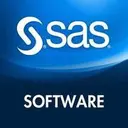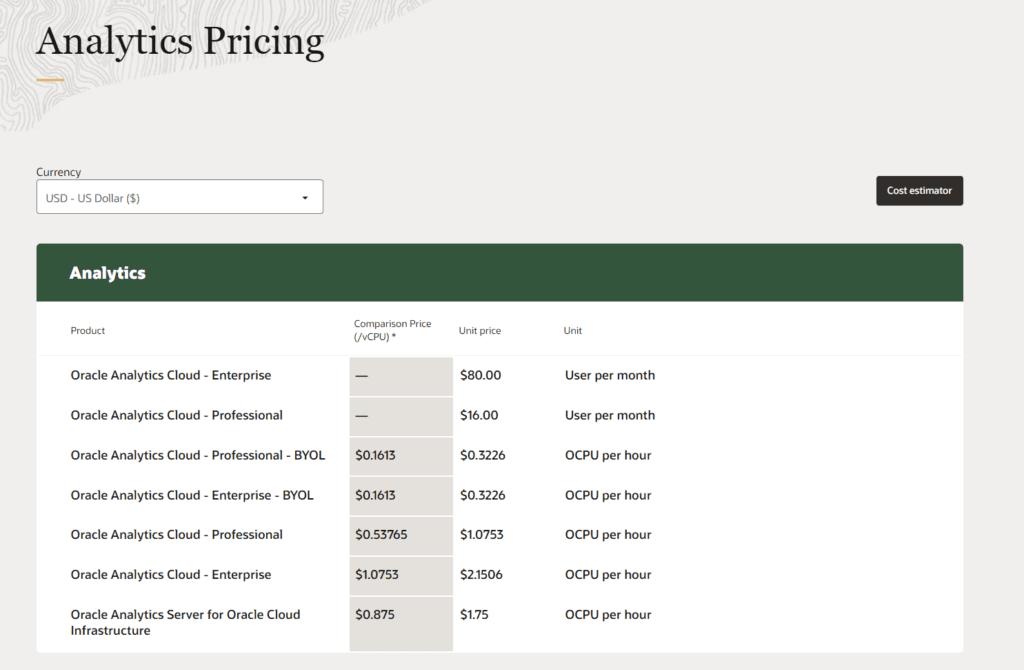Hey there! Are you on a quest to find the analytics tool that will not just meet, but exceed your expectations? Well, you’re in luck! Today, we’re diving deep into the world of data analytics, comparing two giants in the field: Oracle Analytics Cloud and SAS Visual Analytics. Whether you’re crunching numbers, shaping strategies, or just have a knack for understanding data, this showdown is tailor-made for you. We’re cutting through the complexity to give you a clear, straightforward comparison. So, let’s set off on this adventure and discover which tool might just be the key to unlocking your data’s full potential.
| Oracle Analytics Cloud | SAS Visual Analytics |
|---|---|
 |  |
| G2 Score -4.0 out of 5 | G2 Score -4.4 out of 5 |
| TrustRadius Score -8.1 out of 10 | TrustRadius Score -8.4 out of 10 |
Ease of Use and Learning Curve
In the vast sea of analytics, the ease of navigation and the journey to mastery can greatly influence your choice. Let’s see how Oracle Analytics Cloud and SAS Visual Analytics fare in these waters.
Oracle Analytics Cloud: A Seamless Experience
Oracle Analytics Cloud (OAC) aims to make the complex world of data analytics accessible and manageable. It’s designed with the user in mind, featuring an intuitive interface that guides you through data exploration and visualization with ease. Setting up OAC is straightforward, thanks to Oracle’s robust support and comprehensive documentation. Whether you’re a data scientist or a business analyst, the platform is built to get you up and running quickly, turning data into insights without a steep learning curve.
OAC’s strength lies in its versatility and depth, offering powerful analytics capabilities within a user-friendly environment. From creating dashboards to performing advanced analytics, users can leverage a wide range of tools without getting bogged down by overly complex processes. However, mastering the full breadth of OAC’s features may require some time and dedication, especially for those delving into predictive analytics and machine learning.
SAS Visual Analytics: Empowering Users with Insights
SAS Visual Analytics is another strong contender, known for its powerful analytics and visualization capabilities. It’s designed to cater to users of all skill levels, emphasizing an easy-to-use interface that simplifies the analytics process. Users can quickly create reports, interactive dashboards, and visualizations, making data analysis both accessible and engaging.
The platform stands out for its drag-and-drop interface, allowing users to explore data intuitively and craft compelling visual stories with minimal effort. SAS Visual Analytics also offers extensive support resources, including tutorials and user communities, to help smooth the learning curve. While new users can easily grasp basic functionalities, gaining proficiency in more advanced features—such as predictive analytics and scenario analysis—will require additional learning and exploration.
Pricing and Value Proposition
Offer a detailed comparison of the pricing structures for OAC and SAS Visual Analytics, noting any differences in subscription models, licensing fees, and additional costs for premium features or services. Discuss the overall value proposition of each tool, considering the total cost of ownership and the return on investment businesses can expect based on the tool’s features and capabilities.
Pricing Structure of Oracle Analytics Cloud

Oracle Analytics Cloud offers a subscription-based pricing model, which is fairly common for cloud-based analytics platforms. The pricing is tiered, based on the volume of data processed and the number of users accessing the system. Oracle divides its offerings into different packages, catering to various business sizes and requirements—from basic data visualization needs to comprehensive enterprise analytics solutions.
While specific pricing details may require direct engagement with Oracle sales due to the customized nature of enterprise agreements, OAC typically involves a monthly subscription fee that covers data storage, computing resources, and user access. Additionally, Oracle might offer different pricing tiers for varying levels of functionality, such as advanced AI features or additional data storage.
OAC’s pricing model benefits organizations looking for a scalable solution that grows with their analytics requirements, offering the flexibility to add more users or process larger datasets as needed. However, businesses should consider the total cost of ownership, including potential increases in subscription fees as their usage expands.
Pricing Structure of SAS Visual Analytics

SAS Visual Analytics also follows a subscription-based model, but with a focus on offering tailored solutions that can vary significantly in price based on the organization’s size, data needs, and the specific analytics capabilities required. SAS provides a comprehensive suite of analytics tools, and pricing can be affected by factors such as the number of users, the volume of data being analyzed, and whether the deployment is on-premises or cloud-based.
For exact pricing, SAS typically requires a consultation to understand an organization’s needs and tailor the pricing accordingly. This approach allows SAS to offer customized packages that align closely with a business’s requirements but can make it challenging for potential customers to estimate costs without engaging in detailed discussions with SAS representatives.
Like Oracle, SAS’s pricing model is designed to scale, but businesses should be mindful of the long-term costs, especially if they anticipate significant growth in their data analytics activities. On-premises deployments may also incur additional hardware and maintenance expenses.
Security and Compliance
Highlight the security measures and compliance certifications of both analytics platforms. Discuss how each tool ensures the protection of data and complies with international data privacy regulations such as GDPR, HIPAA, and others. This section is crucial for organizations that prioritize data security and need to adhere to strict compliance standards.
Security and Compliance in Oracle Analytics Cloud
Oracle Analytics Cloud benefits from Oracle’s comprehensive approach to cloud security, encompassing a wide array of measures designed to protect data at every layer of the cloud stack. Oracle implements strict security controls, including data encryption at rest and in transit, robust identity and access management policies, and network security measures such as firewalls and intrusion detection systems. These features help safeguard data against unauthorized access and potential breaches.
From a compliance perspective, OAC inherits Oracle Cloud’s adherence to a broad spectrum of global and industry-specific regulations and standards. Oracle Cloud is certified against important compliance frameworks, including GDPR for data protection in Europe, HIPAA for healthcare information in the United States, and SOC 1 and SOC 2 for service organization controls, among others. This extensive compliance coverage ensures that organizations using OAC can meet their regulatory obligations across different regions and industries.
Security and Compliance in SAS Visual Analytics
SAS Visual Analytics is part of the SAS platform, which has a long-standing reputation for security and reliability. SAS provides a comprehensive set of security features, including data encryption, user authentication and authorization, and audit logs that record access and changes to data. These features are designed to ensure that only authorized users can access sensitive information and that all data interactions are transparent and traceable.
Regarding compliance, SAS acknowledges the importance of adhering to legal and regulatory requirements related to data privacy and protection. SAS Visual Analytics supports compliance with major regulations such as GDPR and HIPAA by providing tools and functionalities that help manage data privacy, report on security incidents, and control access to data based on user roles. SAS’s approach to compliance is proactive, with continuous updates to its security practices and policies to align with evolving regulations.

Related: Check out our free SEO suite

Data Integration and Management
Discuss how each platform allows for the integration of data from various sources, including cloud storage, on-premise databases, and third-party applications. Highlight the ease with which users can access, clean, and prepare data for analysis in OAC versus SAS Visual Analytics. This section could explore specific features such as automated data cleansing, integration with big data sources, and support for real-time data analytics.
Data Integration in Oracle Analytics Cloud
Oracle Analytics Cloud stands out for its robust data integration capabilities, designed to streamline the process of consolidating data from a myriad of sources. OAC supports integration with a wide range of data sources, including Oracle’s own extensive suite of enterprise applications, third-party cloud services, on-premise databases, and even spreadsheets. This flexibility ensures that businesses can leverage their existing data infrastructure, minimizing the need for extensive modifications or migrations.
One of the key strengths of OAC is its cloud-native architecture, which facilitates seamless connections to both cloud-based and on-premise data sources. This architecture is complemented by Oracle’s Data Sync tool, which simplifies the process of uploading data from any source into the Oracle cloud, ensuring that the data is ready for analysis with minimal preparation.
Moreover, OAC offers powerful data management features, including automated data preparation and enrichment. These features allow users to clean, transform, and enhance their data directly within the platform, reducing the reliance on external data processing tools and streamlining the analytics workflow.
Data Integration in SAS Visual Analytics
SAS Visual Analytics provides comprehensive data integration capabilities, enabling users to access and analyze data from a vast array of sources. Like OAC, SAS Visual Analytics supports integration with a variety of data repositories, including cloud storage services, on-premise databases, and third-party applications. SAS’s long history in the analytics space means that its platform is built to handle data from virtually any source, ensuring compatibility and flexibility for its users.
A standout feature of SAS Visual Analytics is its emphasis on self-service data preparation. The platform offers intuitive tools that empower users to import, cleanse, and transform data without extensive technical expertise. This self-service approach not only accelerates the data preparation process but also democratizes data access, enabling a broader range of users to participate in the analytics process.
Additionally, SAS Visual Analytics leverages the SAS platform’s advanced data management capabilities, offering features such as data quality monitoring and metadata management. These features ensure that data integrated into SAS Visual Analytics maintains its integrity and is easily manageable, even as the volume and complexity of data sources grow.
Conclusion
Concluding our exploration of Oracle Analytics Cloud (OAC) and SAS Visual Analytics, we’ve navigated through critical areas including ease of use, data integration, pricing, as well as security and compliance. Each of these aspects plays a vital role in determining the right analytics tool for your organization, balancing between operational needs, technical capabilities, budget constraints, and strategic goals.
READ NEXT:
- Creating a Content Calendar: Organizing for Consistency and Impact
- Oracle Analytics Cloud vs QlikView: The Best Analytics Tool for You
- IBM Cognos Analytics vs Optimizely: The Best Analytics Tool for You
- Hotjar vs Kissmetrics: The Best Analytics Tool for You
- Mouseflow vs Looker: The Best Analytics Tool for You
- 11 Marketing Analytics Tools to Elevate Your Data-Driven Strategies
- 29+ Digital Analytics Software to Skyrocket Your Digital ROI






















Comments are closed.